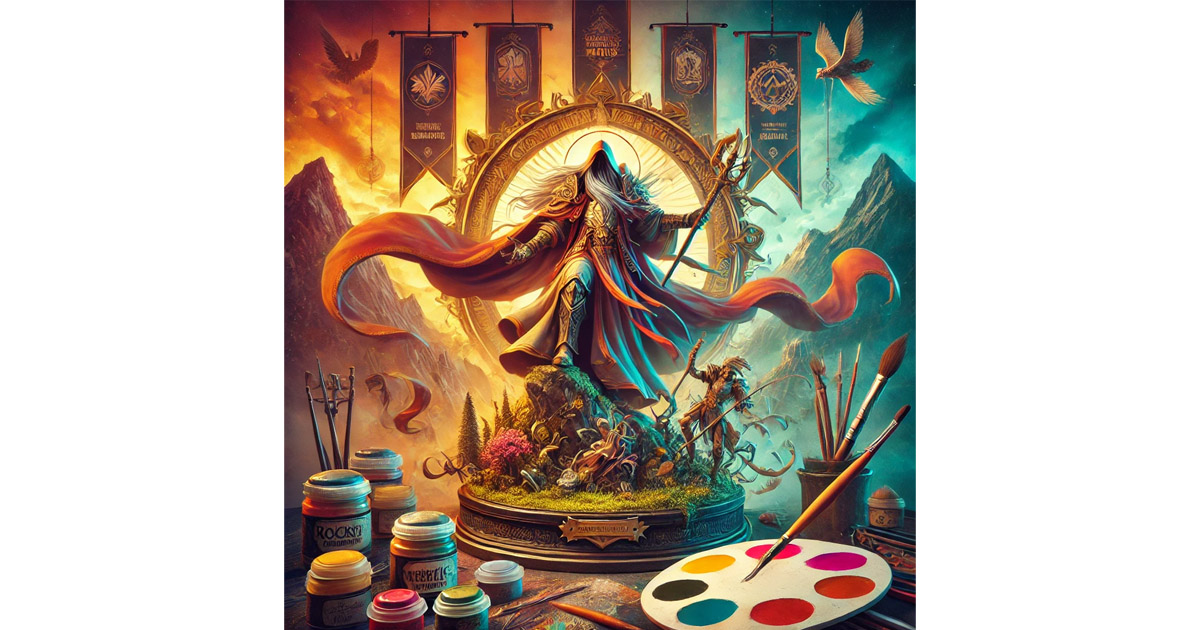Disclosure: This post contains affiliate links. If you click through and make a purchase, I may earn a small commission at no extra cost to you. Thank you for supporting Mythic Minis Studio! For more information read my full disclosure.
Official Judging Criteria Breakdown
Rocky Top Model Painting Competition 2025 – Judging Rubric
Welcome to the Rocky Top Model Painting Competition 2025! Whether you’re a seasoned miniature painter or a newcomer looking to showcase your skills, understanding the judging rubric is key to success. Our expert panel will evaluate each entry based on technical execution, creativity, and overall presentation to ensure a fair and inspiring competition.
In this guide, we’ll break down the official judging criteria, so you know exactly what to focus on to impress the judges and bring your miniatures to life. Let’s dive in and explore what makes an award-winning paint job!
First Cut Guidelines
A “first cut” can be useful. Judges should examine models from a distance of 2-3 feet for obvious flaws like mold lines, visible seams, glue blobs, paint flaws, or assembly issues. If a model has these issues, it fails the first cut and wouldn’t likely proceed in a typical 1-2-3 contest, nor would it be eligible for a bronze medal. However, a model that passes this initial inspection might still have flaws upon closer examination that could disqualify it from receiving an award.
It is important that we provide constructive criticism and positive feedback to disqualified entries. We (judges) should use our scoresheets to point out common flaws and disqualifiers to communicate low scoring and/or medal elimination. This puts the onus on the entrant should they have questions or arguments. That being said, we should also strive to find positives in each entry as a way to commend each entrant’s efforts and encourage them in the hobby and contribute to the community.
We also want to encourage each participant to try again next year, and to participate in other events at their local gaming stores. Thus, criticism should remain positive and constructive.
Judging for Bronze, Silver, and Gold
When judging for Gold, Silver, and Bronze awards, remember that it’s impossible to outline every permutation of flaws. Judges should follow general guidelines, applying judgment, common sense, and experience to assess each model. Although the goal isn’t to narrow down to the top three, judges are still looking for similar flaws and quality indicators to determine which models might earn Gold, Silver, or Bronze.
Categories
Single | Squad/Unit | Monster | Vehicle
Entrants choose which category they’re entering their model into. We have had a few entries in the past where the entrant has let the judges decide the category at registration, and this is fine.
Prizes
Each category will have 1 Gold, 1 Silver, and 1 Bronze winner.
Scoring Breakdown
Scoring has been broken down into three technical criteria, and two aesthetic or artistic areas. The three technical areas will score for fundamental to expert level painting and modeling skills. The two aesthetic criteria will focus more on a comprehensive presentation and creative characteristics that achieve narrative, concept and theme.
22-25 points – Gold Potential Winner
18-21 points – Silver Potential Winner
15-18 points – Bronze Potential Winner
As there cannot be two of the same Medal winners, deliberation and re-examination of each model will commence. Judges will compare notes and re-examine flaws or imperfections in build and paint execution, and they will argue originality and thematic coherence used for the model’s creative aesthetic. Half or quarter points can be used. If fractional points are used, it is advised that the reasoning should be commented and provide quality feedback for every participant.
Workmanship – We’re looking at the quality of the build itself. Common issues are defined as mold lines, gaps, seems, glue marks, assembly issues (instability), surface details such as sanding marks, loss of detail, sprue nubs, flashing.
Scoring Criteria
The following is a list of criteria in which models will be judged. As stated above there are three technical criteria, and two aesthetic or artistic areas in which judges will build their point structures from.
Workmanship
Judges are looking at the quality of the build. Common issues are defined as mold lines, gaps, seems, glue marks, assembly issues (instability), surface details such as sanding marks, loss of detail, sprue nubs, flashing.
- The model has made it to the table.
- The model has mold lines, seams, gaps, glue marks, assembly issues from casual viewing distance (2-3 feet).
- The model has mold lines, seams, gaps, glue marks at closer inspection. The model might also have rough surfaces or detail loss during assembly that is not well restored.
- The model has mold lines, seams, gaps, glue marks only visible with a penlight or magnifier. Lost detail is restored, but not perfect. Level of detail and attention should be consistent throughout the entire model.
- The model is a near perfect build. Conversions and other modifications are near perfect, aligned, and are stable.
Painting Skill
Judges are looking at the quality of the application and usage of paint and decals. Common issues are defined as debris (dust, hair), brush marks, uneven layering, smoothness (over flat surfaces), paint runs, drips, or uncorrected mistakes, washing/shading pooling, smudging or lifting.
- The model is painted and made it to the table.
- Common issues with paint are visible from casual viewing distance (2-3 feet).
- Common issues with paint are visible at closer inspection. Colors are used dynamically and layers are blended fairly well.
- The model has common issues with paint, but are only really visible with a penlight or magnifier.
- Model is painted nearly perfectly. Mistakes are miniscule and require deliberation among the judges. Specialty painting techniques such as OSL, Freehand Detailing, NMM, Glazing, Highlighting, or other are employed and executed well.
Difficulty
Upon entry, judges will use registration sheet to get kit and modification/conversion details from the entrant. It is also important to notify judges of a 3d printed model. 3d printing is not penalized, but instead examined for print complexity and quality. Judges may research manufacturer recommendations and build manuals to assess difficulty with kits we’re not familiar with. Judges are also looking at how the entrant handled building and painting in possible sub-assemblies.
- This is a basic model kit with beginner assembly.
- This is a basic model kit with intermediate assembly.
- This is an advanced model kit and may include some challenging details. The model may include upgrade sprues from another kit.
- This is an advanced model kit with complex features. Model may feature upgrade sprues from another kit or some basic conversions.
- This is an expert model kit with complex features. Model may feature upgrade sprues from another kit or some significant conversions.
Presentation
Presentation is the overall effect of the model, base and use of elements within to create a cohesive and thematic display. Judges would assess its impression the model leaves on the viewer; the visual impact, emotional resonance, and the wow factor it generates.
- Theme Adherence – The model has a clear, readable theme.
- The model is based with the most fundamental basing elements.
- Is uniform attention to detail equal across the entire model, or on just key areas of the model?
- Quality of base or diorama. The base is well integrated with the model. The base enhances the overall presentation and complements the model.
- The model is well composed within its display space. The arrangement is visually appealing and balanced and effectively draws attention to key focal points or features. (ie: focal points guide the viewers’ exploration of the model).
Creativity
Judges look for original ideas and concepts that go beyond common tropes or clichés within the fantasy and sci-fi genres. Models that offer fresh interpretations or introduce innovative elements stand out in terms of creativity.
- Basic paint schemes and basing for a fantasy or sci-fi theme is used and easily identifiable on the model.
- Model uses intermediate elements to drive the theme of the model. This can be use of textures, weathering, basing materials, etc.
- Conversions, modifications, or external elements (3D printed elements) or unconventional materials are used to contribute to the theme or narrative of the model.
- Uses of light and shadow, or specialty painting techniques (OSL, NMM, Glazing, Highlighting, Freehand) are used to drive the narrative of the model.
- Model provokes curiosity, inspires awe, or evokes a sense of wonder through creative vision and execution.


No responses yet